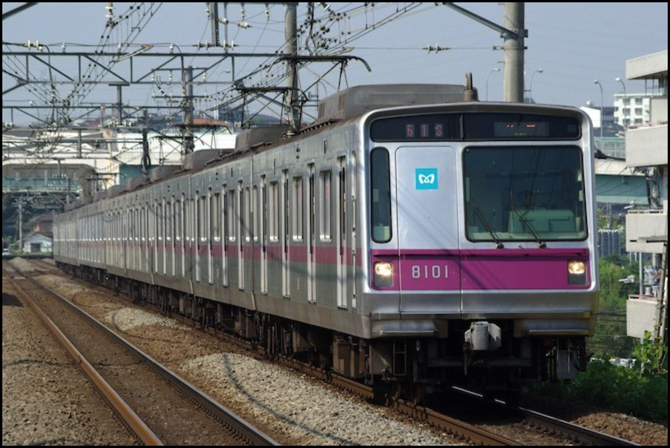Subways of Tōkyō
18 June 2011 01:03 Filed in: Prototype,Model Trains

You’d think someone who’s built a Tōkyō-inspired model railroad with a subway on it would know a bit about the subways of Tōkyō. But in fact when I started construction I knew next to nothing, and I’ve only recently begun to rectify that. Part of the reason is that I’ve been focused on the commuter trains of JR East, and JR doesn’t operate any subway lines (although they do operate a couple of subway trains, as we’ll see in a bit). And part of it was that models of subway trains weren’t all that common, and I hadn’t collected any.
As you can see from the photo of a Tōkyō Metro 8000 Series above (from Wikipedia), the trains don’t look all that different from commuter trains, and that’s because for the most part, they really aren’t. Some of the trains are actually commuter models with relatively minor body changes, while others are more original designs, but still inherit control systems and structures from the narrow-gauge commuter line trains.
To be clear, a “subway” is a heavy-rail line, as distinct from light-rail trolley lines, but it’s a heavy-rail line built at least partially underground, and typically using narrower and often shorter trains to lower the cost of tunnels and permit sharp turns in space-constrained stations. Emergency exits located on the front and rear are also common, as exiting through the side doors may not be practical in a tunnel.
There are thirteen subway lines in Tōkyō, operated by two companies. Most of these use the same 1067mm (3’ 6”) track and overhead 1500V DC power as the commuter lines, and in fact many interoperate with commuter lines, allowing trains from the suburbs to reach deep into the city. A couple of lines use different gauges because they originated from railways that used those gauges above ground and some of those also interoperate with non-JR surface railways. And the two earliest lines in the city are Standard Gauge, likely due to the influence of European or American consultants when they were being designed.
When subway and commuter lines interconnect, not all trains will be able to run between them. The various kinds of automatic-train-stop safety equipment are largely responsible for that, as different lines use different systems. Often a train that works between subway and surface lines will have two or even three sets of such equipment. Many subway trains use the same 20-meter car length and eight or even ten-car trains, so their capacity is not substantially different from a commuter train. But some are smaller, or use shorter trains, and this is probably a factor as well. The result is that some trains are restricted to commuter lines, some to subway lines, and some can work between a set of surface and subway lines. This adds yet more complexity to the Tōkyō passenger railroading scene, and is something else for me to consider in my modeling. I can’t run just any commuter train into my subway line from the surface commuter line. Well, not if I want to be vaguely prototypical.
MicroAce tends to make the most subway train models, followed by Greenmax. I picked up a Greenmax model of the Tōkyō Metro 10000 Series train last winter (basic set and expansion set), which is still available. Most of their other models are of older trains, which don’t interest me. However, MicroAce recently announced plans for a model of the E231-800 train used on the Tōkyō Metro Tōzai line. This is actually a JR train, and it operates on JR’s Chūō-Sōbu line as well, which makes it even more interesting to me. As you might guess from the number, this is a variant of the E231 Series used on the commuter lines.
And Kato has just announced their planned release of a model of the Ginza Line Series 01 train, due out in September. This is particularly interesting as it is one of the two third-rail powered lines, and the oldest subway line in Asia, dating from 1927. It’s also a relatively inexpensive model, as the line uses six-car trains. The Ginza trains are also very similar to the 02 Series used on the other third-rail line, the Marunouchi line. And that’s the line that briefly appears crossing a river next to Ochanomizu station, the prototype for my own Riverside Station and its subway line. So having a Ginza train was important to me. So important, in fact, that I’ve pre-ordered two of them. So by this fall, I’ll have gone from having one subway train model to four.
I think I’ll stop for a bit now. Unless someone releases another modern Tōzai-line train, like the 05N, the 15000 or the E233-2000, in which case I expect my self-restraint to fail me (for more about these, and other prototype Tōkyō subway trains, see my new Subway Trains page).
Other website updates:
- Added a new track plan and a bit of text to my Urban Tram Layout page. My ideas for this are beginning to settle down.
- Updated the Roster and Reservations pages.
- Added a bit to the “Phase 2l” Construction page about weathering Unitrack (more on this to come).
- Added some photos of my latest flicker-control circuit board to my Light Board page. This is starting to come together, and what I need to do next is build another eight of them to finish the ten-car test train, then see how well it works in practice.
- Added photos to the Roster and Electronics photo albums.




